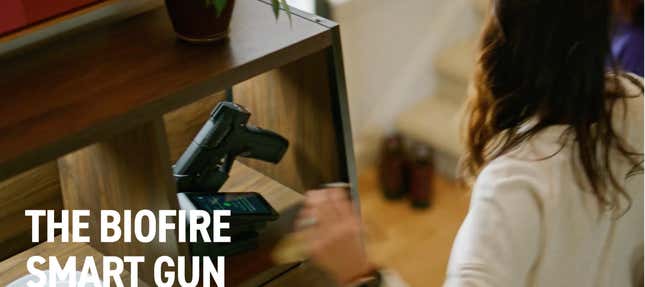After decades of hype, biometrically enabled “smart” guns are officially on the market. Colorado-based Biofire Technologies this week said it released the first commercially available smart handgun which uses a fingerprint and facial recognition biometrics identity verification tool to unlock a 9mm handgun intended for home defense. The release could set off a new arms race among smart gun manufacturers eager to cash-in on a gun-addicted nation rattled by a horror-show of accidental and unnecessary firearm deaths.
Biofire, like other smart gun startups, claims its reliance on biometrics to unlock firearms could play a key role in preventing accidental suicides, particularly among children. Firearms, according to data from the Centers for Disease Control and Prevention, were the number one cause of death for children in 2020. Gun-related deaths generally saw their highest peak the same year, with 45,222 firearm-related deaths recorded in the U.S. alone. Smart guns as a concept isn’t new by any means, but Biofire believes its model is the first one that will actually work as intended while still preventing unauthorized access.
Advertisement
“We’ve applied high-precision engineering principles to make a meaningful impact on preventable firearm deaths among children,” Biofire founder and CEO Kai Kloepfer said in a statement
How does the smart gun work?
Biofire’s promotional material shows videos of a family running around their house with the firearm causally locked in its dock atop a bookshelf. In the videos, the 9mm handgun could almost be mistaken for one of many appliances left charging on a shelf overnight. The company claims its smart gun, “locks the moment it leaves your hand,” making it basically little more than a paperweight in unauthorized users’ hands. The gun’s owners can add or remove “trusted users” while the gun rests on its Smart Doc in a process reminiscent of adding fingerprints or face scans to unlock an iphone.
Advertisement
Advertisement

For those who are authorized, the smart gun reads the user’s fingerprint and scans their face the moment they grab the gun, eliminating the need for a code or key to unlock it. Those two biometric systems verify a user’s identity independently—whichever one verifies the identity first unlocks it first. Biofire claims a user’s biometric data is stored on the gun and never leaves it. The firearm itself is powered by a rechargeable battery and reportedly uses encryption to prevent bad actors from retrofitting it into a traditional firearm. Gun owners interested in purchasing the $1600 pistol can customize its polymer and trigger colors much like customizing a pair of Nike sneakers or a Domino’s pizza.
Advertisement
“Your Smart Gun only fires for the people you choose, so your firearm can never cause a tragic outcome in the hands of a child, criminal, or anyone else,” the company claims.
Why are smart guns up for sale now?
Besides acting as a safeguard against accidental child suicides, there’s another clear draw for smart guns: limiting mass shootings. A recent spate of mass shootings across the U.S. has left communities and lawmakers, once again, clambering for legislative reforms. Republican lawmakers have basically admitted new gun restrictions or regulations are off the table. It’s in that total absence of responsibility that smart guns could theoretically provide some relief.
Advertisement
Biometric identifiers like fingerprint scanners or facial recognition could make it much more difficult for minors or those unable to legally acquire a gun to carry out attacks with borrowed or stolen firearms. Such safety measures, for example, could have played a preventative role in the 2012 Sandy Hook elementary school shooting where the gunman used his mothers’ weapons to carry out the attack. At the same time, recent research from the National Institute of Justice determined the vast majority (77%) of mass shooters between 1966 and 2019 purchased at least one legal firearm used to carry out their acts of violence. More than 80% of the people responsible for shootings at K-12 schools, however, did steal guns from their families. In other words, smart guns could help reduce mass shootings, especially in schools but it likely won’t really make a dent in addressing the wider problem of easily accessible guns.
The less exciting, but more likely explanation for why smart guns are starting to hit store shelves is that gun owners are finally ready for them. More than half (56%) of U.S. gun owners surveyed in a Morning Consult poll last year said they supported the development of smart guns while 55% said they would feel comfortable using one. Those figures are a far cry from surveys carried out just two years earlier where only 19% of gun owners expressed even slight interest in buying a smart gun. Even though the underlying technology empowering smart guns has existed for years, major gun lobbies like the National Rifle Association have fiercely lobbied against them to the point where it even led boycotts against legacy gunmakers Remington and Smith & Wesson when they tried to pursue the tech. Now, nearly twenty years later, the tides appear to be turning.
Advertisement
“It’s been around a long time now,” LodeStar Works President and CEO Gareth Glaser said when asked about gun owners’ newfound acceptance of smart guns. “Everybody uses one form or another of authentication technology on their smartphone.”
Biofire’s new smart gun will have plenty of competition soon. Multiple startup smart gun manufacturers, including LodeStar Works and the unfortunately named SmartGunz LLC are both planning to release their models which rely on a mix of fingerprints and radio frequencies for identity verification in the near future.
Services Marketplace – Listings, Bookings & Reviews